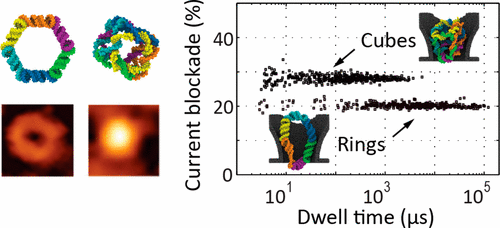Our official English website, www.x-mol.net, welcomes your
feedback! (Note: you will need to create a separate account there.)
Picomolar Fingerprinting of Nucleic Acid Nanoparticles Using Solid-State Nanopores
ACS Nano ( IF 15.8 ) Pub Date : 2017-09-11 00:00:00 , DOI: 10.1021/acsnano.7b04923 Mohammad Amin Alibakhshi , Justin R. Halman , James Wilson 1 , Aleksei Aksimentiev 1 , Kirill A. Afonin , Meni Wanunu
ACS Nano ( IF 15.8 ) Pub Date : 2017-09-11 00:00:00 , DOI: 10.1021/acsnano.7b04923 Mohammad Amin Alibakhshi , Justin R. Halman , James Wilson 1 , Aleksei Aksimentiev 1 , Kirill A. Afonin , Meni Wanunu
Affiliation

|
Nucleic acid nanoparticles (NANPs) are an emerging class of programmable structures with tunable shape and function. Their promise as tools for fundamental biophysics studies, molecular sensing, and therapeutic applications necessitates methods for their detection and characterization at the single-particle level. In this work, we study electrophoretic transport of individual ring-shaped and cube-shaped NANPs through solid-state nanopores. In the optimal nanopore size range, the particles must deform to pass through, which considerably increases their residence time within the pore. Such anomalously long residence times permit detection of picomolar amounts of NANPs when nanopore measurements are carried out at a high transmembrane bias. In the case of a NANP mixture, the type of individual particle passing through nanopores can be efficiently determined from analysis of a single electrical pulse. Molecular dynamics simulations provide insight into the mechanical barrier to transport of the NANPs and corroborate the difference in the signal amplitudes observed for the two types of particles. Our study serves as a basis for label-free analysis of soft programmable-shape nanoparticles.
中文翻译:

使用固态纳米孔的核酸纳米颗粒的皮摩尔指纹图谱
核酸纳米颗粒(NANP)是一类新兴的可编程结构,具有可调整的形状和功能。它们作为基础生物物理学研究,分子传感和治疗应用的工具的前途使他们有必要在单粒子水平上进行检测和表征的方法。在这项工作中,我们研究了通过固态纳米孔对单个环状和立方体形NANP的电泳迁移。在最佳的纳米孔尺寸范围内,颗粒必须变形才能通过,这会大大增加其在孔中的停留时间。当在高跨膜偏压下进行纳米孔测量时,这种异常长的停留时间可检测到皮摩尔量的NANP。如果是NANP混合物,可以通过对单个电脉冲的分析来有效地确定穿过纳米孔的单个颗粒的类型。分子动力学模拟提供了对NANP传输的机械障碍的洞察力,并证实了两种颗粒观察到的信号幅度的差异。我们的研究为软可编程形状纳米颗粒的无标签分析奠定了基础。
更新日期:2017-09-11
中文翻译:

使用固态纳米孔的核酸纳米颗粒的皮摩尔指纹图谱
核酸纳米颗粒(NANP)是一类新兴的可编程结构,具有可调整的形状和功能。它们作为基础生物物理学研究,分子传感和治疗应用的工具的前途使他们有必要在单粒子水平上进行检测和表征的方法。在这项工作中,我们研究了通过固态纳米孔对单个环状和立方体形NANP的电泳迁移。在最佳的纳米孔尺寸范围内,颗粒必须变形才能通过,这会大大增加其在孔中的停留时间。当在高跨膜偏压下进行纳米孔测量时,这种异常长的停留时间可检测到皮摩尔量的NANP。如果是NANP混合物,可以通过对单个电脉冲的分析来有效地确定穿过纳米孔的单个颗粒的类型。分子动力学模拟提供了对NANP传输的机械障碍的洞察力,并证实了两种颗粒观察到的信号幅度的差异。我们的研究为软可编程形状纳米颗粒的无标签分析奠定了基础。









































 京公网安备 11010802027423号
京公网安备 11010802027423号